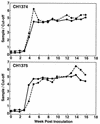Hepatitis E virus (HEV) capsid antigens derived from viruses of human and swine origin are equally efficient for detecting anti-HEV by enzyme immunoassay
- PMID: 12454155
- PMCID: PMC154628
- DOI: 10.1128/JCM.40.12.4576-4580.2002
Hepatitis E virus (HEV) capsid antigens derived from viruses of human and swine origin are equally efficient for detecting anti-HEV by enzyme immunoassay
Abstract
The recombinant truncated ORF2 (capsid) antigen derived from the Meng strain of swine hepatitis E virus (HEV) differs from that of the Sar-55 strain of human HEV by approximately 5% at the amino acid level. Serial serum samples from two chimpanzees and six rhesus monkeys experimentally infected with HEV were tested with one enzyme immunoassay (EIA) based on the Sar-55 antigen and with a second EIA based on the Meng antigen. We obtained 98% agreement (kappa = 0.952) by direct comparison. The virtually identical results obtained with these antigens in detecting seroconversion following infection with HEV suggests that they were reacting with antibodies that detect the same or very similar epitopes of HEV. We then tested human and swine serum samples for anti-HEV in EIAs that utilized one or the other of the two ORF2 antigens and showed that these results were also virtually identical. The specimens tested included swine sera from the United States, Canada, China, Korea, and Thailand and sera from veterinarians, U.S. and non-U.S. volunteer blood donors, and U.S. and non-U.S. animal handlers. We tested 792 swine sera and obtained 93% agreement (kappa = 0.839). We similarly tested 882 human sera and obtained 99% agreement (kappa = 0.938). Moreover, we found virtually no difference in the levels of prevalence of anti-HEV as measured by the two tests, again suggesting that the antigens derived from human and swine HEV contain the same immunodominant epitopes.
Figures


References
-
- Anderson, D. A., F. Li, M. Riddell, T. Howard, H. F. Seow, J. Torresi, G. Perry, D. Sumarsidi, S. M. Shrestha, and I. L. Shrestha. 1999. ELISA for IgG-class antibody to hepatitis E virus based on a highly conserved, conformational epitope expressed in Escherichia coli. J. Virol. Methods 81:131-142. - PubMed
-
- Balayan, M. S., A. G. Andjaparidze, S. S. Savinskaya, E. S. Ketiladze, D. M. Braginsky, A. P. Savinov, and V. F. Poleschuk. 1983. Evidence for a virus in non-A, non-B hepatitis transmitted via the fecal-oral route. Intervirology 20:23-31. - PubMed
-
- Berke, T., and D. O. Matson. 2000. Reclassification of the Caliciviridae into distinct genera and exclusion of hepatitis E virus from the family on the basis of comparative phylogenetic analysis. Arch. Virol. 145:1421-1436. - PubMed
-
- Bradley, D., K. Krawczynski, E. H. Cook, K. A. McCaustland, B. H. Robertson, M. A. Kane, J. Spelbring, C. D. Humphrey, I. Weisfuse, A. Andjaparidze, M. Balayan, H. Stetler, and O. Velazquez. 1988. Enterically transmitted non-A, non-B hepatitis: etiology of disease and laboratory studies in non-human primates, p. 138-147. In A. J. Zuckerman (ed.), Viral hepatitis and liver disease. Alan R. Liss, Inc., New York, N.Y.
Publication types
MeSH terms
Substances
LinkOut - more resources
Full Text Sources
Miscellaneous

